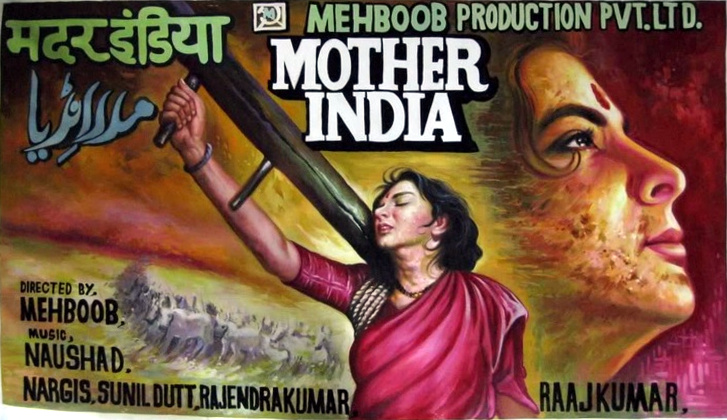Mother India is a monumental and deeply disturbing film. (Spoilers ahead!) Released in 1957, ten years after the Partition of India and independence, the film features Bombay leading lady Nargis as Radha, the mother of a family and an archetype of Indian motherhood. When the film opens, it is the present day (the mid-fifties), and a canal has just been completed. Radha, the oldest resident of the village nearby, is given the honor of pulling a rope to release water into the canal at the dedication ceremony.
As Radha is grasping the rope and just about to pull it, the narrative shifts back to when Radha was a young woman and a newly-married bride. Most of the rest of the movie takes place in this flashback. Radha’s adult life is a series of calamities: her husband loses his arms in a farming accident and abandons the family to die alone, the village is washed away in a flood, and Radha’s baby is killed. Then when Radha’s two surviving sons grow up, Birju, the ever-rebellious younger son, terrorizes the villagers and turns to a life of banditry. Birju murders the village landlord, and in the end Radha herself wields a rifle to shoot her wicked son and end his reign of terror once and for all.
After Birju dies in his mother’s arms, the flashback ends, and Radha is back at the dedication of the canal. She pulls the rope, and water rolls through canal’s gate—red at first, then clear. And thus the film ends.
Why is the water in the canal red? Because the scene takes place immediately after the son’s death, it is clear that the red water is a symbol of Birju’s blood, shed for the good of the village. To me, the red water in the canal has a broader significance as well, and it is this—more the kin-murder—that makes the film so disturbing.
I read Mother India as a metaphor of socialist nation-building. Birju’s murdering the landlord represents land reform. In turn, Radha’s killing Birju refers to the rooting out of dissident anti-national elements to create a homogeneous socialist society. This happened on a large scale in China and the Soviet Union, and on a smaller scale in India. As in the large communist countries, the Indian government suppressed certain indigenous and other non-mainstream communities in the interest of national unity.1 India’s socialist development also dispossessed untold millions of villagers as land was cleared for infrastructural projects such as the canal that Radha dedicates. These people’s blood is also in Mother India’s canal.
- To be fair, capitalism could be just as destructive of non-mainstream communities. Consider the systematic destruction of Native American communities during westward expansion in the United States. [↩]






Leave a Reply